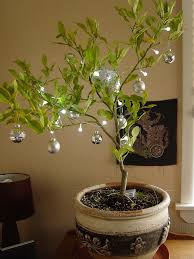This e-mail, like last week's, reports on a basal citrus fruit that I have encountered only through the Internet. ("Basal" means that it lies at the beginning of a burst of evolution and has numerous descendants.)
Papeda is a sub-genus of Citrus. Most members of this sub-genus are considered inedible. Uses include landscaping and providing rootstocks for more desirable citrus plants. As an example, here is a picture of the Ichang papeda (Citrus ichangensis). This fruit is apparently about the same size as a mandarin, i.e., it is quite small.
The member of Papeda that this e-mail focuses on is the kaffir lime (Citrus hystrix) since this appears to be the member of the sub-genus that is the ancestor of the limes that we eat. Advanced thinkers say that the traditional name "kaffir lime" is offensive to some and advocate use of the preferred name "makrut lime." I will stick with the traditional name since the advanced thinkers don't seem to have yet affected usage on the Internet or in the market. Here are pictures of the kaffir lime trees, fruit, leaves, and flowers. Note that the leaves have a characteristic figure-eight shape. The last picture shows the lime swallowtail butterfly caterpillar.
Some use is made of the kaffir lime zest and of the rind to make a curry paste, but the main part of the plant that is used is the leaves. The leaves can be powdered and made into a paste, but they are usually used as seasoning; Mei-Mei tells me that they are like bay leaves and should be picked out of the dish rather than eaten. Mei-Mei, who occasionally uses these leaves, says, "They are perfumed and have a very appealing tang." (Mei-Mei reports that the store in Brattleboro where she has traditionally purchased these leaves has gone out of business. If anyone knows where to buy fresh (not packaged) leaves, please let Mei-Mei or me know. My mainstream stores don't sell them.) In addition, the leaves are used when cooking snails to mask the pungent odor. The distinctive odor of the leaves comes from citronellal.
There are a number of commercial products made from the kaffir lime, starting with kaffir lime vinegar and dishwashing liquid, and ending with Jalepeno and kaffir lime raspberry preserves and a tee shirt..
Kaffir lime has been incorporated into a few beauty products.
The kaffir lime has contributed its mite to alcoholic beverages.
- Kaffir lime and gin ice cream
- Sweet Kaffir lime liqueur (and how to make it at http://www.evilmadscientist.
com/2013/kaffir-limoncello/) - Kaffir lime vodka (and how to make it https://www.pinterest.com/
recipes/kaffir-lime-vodka/) - Kaffir lime leaf vodka shaken with lychee liqueur
- Kaffir margarita
- Kaffir lime and coconut cordial
- Kaffir lime vodka (2 pictures)
Since kaffir limes have been around for a long time, they have made their way into a wide range of homemade dishes. Cooks can consult these ten easy recipes, or can try to reproduce the dishes pictured below.
- Kaffir lime bundt cake
- Kaffir lime coconut tart
- Fish curry with kaffir lime leaves
- Vietnamese grilled chicken in kaffir lime leaves
- Thai green curry stir fry with kaffir lime leaves
- Chicken coconut soup with kaffir lime leaves
- Green chili in kaffir lime sauce
- Kaffir lime and coconut macaroon
- Kaffir lime and lemon grass grilled trout
- Kaffir lime ganache
- Kaffir limeade
- Kaffir lime fried chicken sandwich
- Kaffir lime and lemon grass cupcake with coconut frosting
I have found only one art object, namely a kaffir lime Christmas tree.
Since I didn't try a kaffir lime, there is no verdict, but no one should attempt to eat a raw kaffir lime.
In summary, the importance of the kaffir lime lies mainly in its contribution to Asian cuisine and, as will be seen in a coming e-mail, in its giving rise to descendant citrus fruits.
Rick
P.S. Below is "Sticker Shock III." You can see from all the pink on the rightmost third that I have been eating a lot of cara cara navel oranges (PLU #3110). Also, many of the other stickers are for large (#4012) or small (#4013) navels. (All those stickers with an orange top, a green bottom, and a bar code in the middle are for large navels.) In short, we have just passed through the peak of navel orange season, and I have not failed to notice it. An innovation is that this art work is scanned, not photographed. I still have all three of the original Sticker Shock pieces; none have yet sold to collectors of Fruit Exploriania.


























































No comments:
Post a Comment